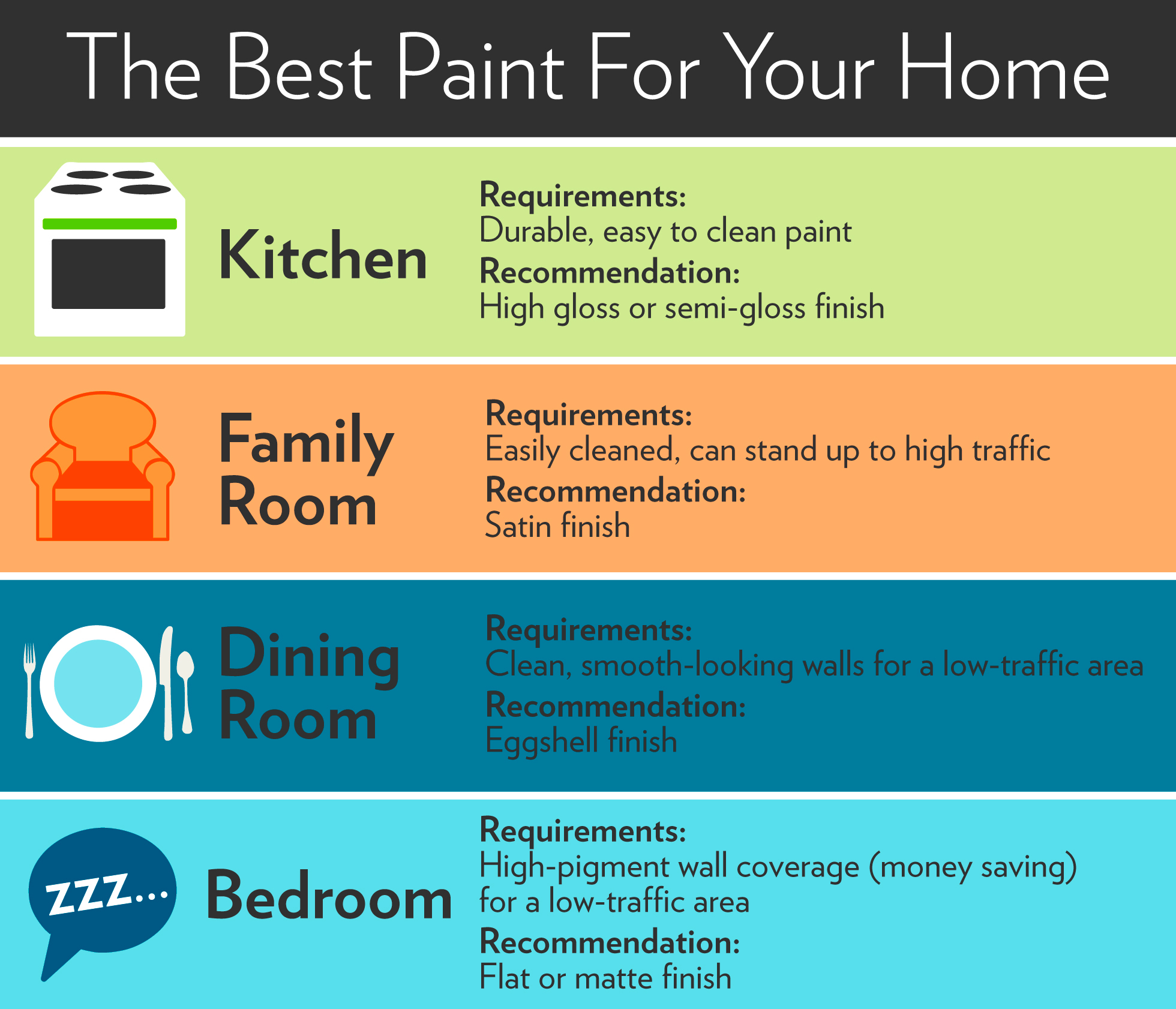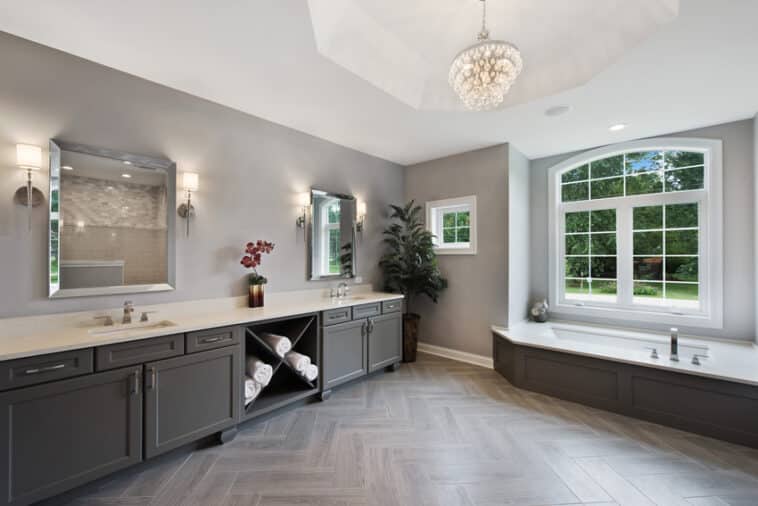Bathroom Paint Finish Considerations: What Paint Finish For Bathroom

Choosing the right paint finish for your bathroom is crucial for achieving both aesthetic appeal and practical functionality. Different finishes offer varying levels of durability, moisture resistance, and ease of cleaning, making it essential to select the best option for each bathroom area.
Matte Finish
Matte finishes are characterized by their flat, non-reflective surface, which creates a soft, sophisticated look. They are particularly effective at hiding imperfections in the walls, making them a popular choice for bathrooms with uneven surfaces. However, matte finishes are more porous than other options, making them susceptible to stains and less durable. They are generally not recommended for high-traffic areas or areas prone to moisture.
Eggshell Finish
Eggshell finishes offer a slightly sheen finish that provides a subtle elegance without being overly glossy. They are known for their durability and ease of cleaning, making them a good choice for bathroom walls. Eggshell finishes offer a balance between a matte finish’s soft look and a satin finish’s durability, making them a popular choice for bathrooms.
Satin Finish, What paint finish for bathroom
Satin finishes are slightly more reflective than eggshell finishes, providing a subtle sheen that enhances the room’s light and adds a touch of elegance. They are known for their durability and moisture resistance, making them suitable for bathroom walls and trim. Satin finishes are easier to clean than matte or eggshell finishes, making them a practical choice for areas prone to moisture and splashes.
Semi-Gloss Finish
Semi-gloss finishes offer a noticeable sheen that provides a clean, modern look. They are highly resistant to moisture and stains, making them ideal for bathroom trim, doors, and cabinets. Their durability and ease of cleaning make them a practical choice for areas that require frequent cleaning.
Gloss Finish
Gloss finishes are highly reflective, providing a high-shine finish that adds a touch of drama and sophistication to a bathroom. They are the most durable and moisture-resistant of all paint finishes, making them suitable for areas that require frequent cleaning and withstand moisture, such as bathroom trim, doors, and cabinets. However, gloss finishes can highlight imperfections in the walls, making them less ideal for surfaces with unevenness.
Paint Finish Comparison Table
| Paint Finish | Key Characteristics | Suitability for Bathroom Areas | Overall Benefits |
|---|---|---|---|
| Matte | Flat, non-reflective surface, hides imperfections, porous, susceptible to stains | Walls (with minor imperfections) | Soft, sophisticated look, hides imperfections |
| Eggshell | Slightly sheen, durable, easy to clean | Walls, trim | Balance of matte’s softness and satin’s durability, good for general use |
| Satin | Subtle sheen, durable, moisture-resistant, easy to clean | Walls, trim | Durable, moisture-resistant, easy to clean, good for high-traffic areas |
| Semi-gloss | Noticeable sheen, highly moisture-resistant, easy to clean | Trim, doors, cabinets | Durable, moisture-resistant, easy to clean, good for high-moisture areas |
| Gloss | Highly reflective, high-shine finish, most durable, moisture-resistant | Trim, doors, cabinets | Most durable, moisture-resistant, easy to clean, high-shine finish |
Choosing the Right Paint for Bathroom Walls

Bathrooms are prone to moisture, humidity, and mildew, making it crucial to choose a paint specifically designed to withstand these conditions. Regular interior paints can deteriorate quickly in such environments, leading to peeling, cracking, and mold growth.
Selecting Mildew-Resistant and Moisture-Resistant Paint
Choosing a paint with mildew-resistant properties and high moisture resistance is essential for ensuring long-lasting and aesthetically pleasing results in your bathroom.
- Look for Paints Labeled “Mildew-Resistant” or “Antimicrobial”: These paints contain additives that inhibit the growth of mildew and mold, preventing unsightly stains and potential health hazards.
- Opt for Paints with a High Moisture Resistance Rating: Paints with a high moisture resistance rating are better equipped to withstand the constant presence of moisture in bathrooms, minimizing the risk of peeling, cracking, and damage.
- Consider Acrylic Latex Paints: Acrylic latex paints are generally a good choice for bathrooms due to their excellent moisture resistance, durability, and ease of cleaning.
- Explore Epoxy Paints for High-Moisture Areas: Epoxy paints offer superior moisture resistance and durability, making them ideal for areas like showers, tubs, and around sinks.
Benefits of Using a Primer Before Painting Bathroom Walls
Applying a primer before painting bathroom walls is a crucial step that enhances the overall finish and longevity of the paint job.
- Prevents Moisture Damage: A primer acts as a barrier, preventing moisture from penetrating the wall and causing damage to the paint.
- Creates a Smooth Surface: Primers help to create a smooth and even surface, improving the adhesion of the top coat and resulting in a more professional-looking finish.
- Enhances Paint Coverage: Primers help to seal the surface, preventing the top coat from being absorbed by the wall and ensuring better coverage.
- Provides a Moisture-Resistant Base: A primer with moisture-resistant properties further enhances the protection against moisture damage, ensuring a durable and long-lasting paint job.
Preparing Bathroom Walls for Painting
Proper preparation of bathroom walls is essential for a successful and long-lasting paint job. This involves cleaning, patching, and sanding the surface to create a smooth and primed base for the paint.
- Clean the Walls Thoroughly: Start by removing any dirt, dust, cobwebs, and loose paint using a damp cloth or sponge. For stubborn stains, use a mild detergent or a specialized cleaning solution for bathroom surfaces.
- Patch Any Cracks or Holes: Use a patching compound or spackle to fill any cracks, holes, or imperfections in the walls. Allow the patching compound to dry completely before sanding it smooth.
- Sand the Walls Smooth: Sand the walls lightly using fine-grit sandpaper to remove any rough edges or bumps. This creates a smooth surface that will allow the paint to adhere evenly.
- Apply a Primer: After cleaning, patching, and sanding, apply a primer specifically designed for bathroom walls. Choose a primer with mildew-resistant properties and high moisture resistance to ensure a durable and long-lasting finish.
Essential Painting Tools for Bathroom Projects
Having the right tools on hand will make your bathroom painting project easier and more efficient.
- Paint Brushes: Use a variety of sizes and shapes to reach different areas, corners, and edges. Choose brushes with high-quality bristles for a smooth finish.
- Paint Rollers: Opt for rollers with nap lengths appropriate for the type of paint and surface being painted. A longer nap roller is suitable for textured surfaces, while a shorter nap roller is ideal for smooth surfaces.
- Drop Cloths: Protect your floors and surrounding areas from paint splatters and spills. Use plastic drop cloths for easy cleanup and washable drop cloths for more permanent protection.
- Painter’s Tape: Mask off areas that you don’t want to paint, such as trim, windows, and doors. Choose high-quality painter’s tape for clean lines and easy removal.
- Paint Tray and Liner: Pour the paint into a paint tray with a liner to make application easier and prevent spills. Use a roller grid to evenly distribute the paint on the roller.
- Paint Stir Stick: Thoroughly mix the paint before and during application to ensure an even consistency and color.
- Safety Glasses and Gloves: Protect your eyes and hands from paint splatters and fumes.
Bathroom Paint Color Inspiration

Choosing the right paint color for your bathroom can significantly impact the overall feel and atmosphere of the space. From creating a calming oasis to adding a touch of vibrancy, color plays a crucial role in bathroom design.
Color Psychology in Bathroom Design
The colors we choose for our bathrooms can influence our mood and well-being. For instance, cool colors like blue and green are often associated with relaxation and tranquility, making them ideal for creating a spa-like ambiance. Warm colors like yellow and orange can evoke feelings of energy and optimism, making them suitable for smaller bathrooms that need a boost of brightness.
- Blue: Known for its calming and serene effect, blue is a popular choice for bathrooms. It promotes relaxation, reduces stress, and creates a sense of peace.
- Green: Often associated with nature, green is believed to have a restorative effect on the mind and body. It can help to create a feeling of balance and harmony, making it a good choice for bathrooms with a natural theme.
- Yellow: A cheerful and uplifting color, yellow can brighten up a small bathroom and create a sense of warmth. It can also stimulate creativity and enhance focus.
- Orange: Known for its energizing and stimulating properties, orange can add a touch of vibrancy to a bathroom. It can also create a feeling of warmth and comfort.
Using Color to Enhance Bathroom Space
Color can be a powerful tool for enhancing the size and shape of a bathroom. Light colors tend to make spaces feel larger and more open, while dark colors can create a sense of intimacy and coziness.
- Light Colors for Small Bathrooms: Painting a small bathroom in a light color like white, cream, or pale blue can help to create the illusion of more space. Light colors reflect light, making the room feel brighter and more spacious.
- Dark Colors for Large Bathrooms: A large bathroom can handle a darker color palette without feeling cramped. Dark colors can create a sense of intimacy and sophistication, making the space feel more inviting and luxurious.
- Color Blocking: Using different colors on different walls can create visual interest and define different areas within the bathroom. For example, you could paint the back wall of a shower stall a darker color to create a focal point, while keeping the rest of the bathroom in a lighter hue.
- Vertical Stripes: Painting vertical stripes in a lighter color can make a room appear taller, while horizontal stripes can create a sense of width. This technique can be particularly effective in bathrooms with low ceilings or narrow spaces.
Bathroom Color Palette Mood Boards
Here are a few mood boards showcasing different bathroom color palettes:
1. Modern Minimalist:
What paint finish for bathroom –
White walls, grey accents, and a touch of black create a sleek and sophisticated look.
- Walls: White or a very light grey.
- Accents: Dark grey towels, black hardware, and a few black and white accessories.
- Flooring: Grey or white tile.
2. Spa-Inspired Tranquility:
Soft blues and greens create a calming and relaxing atmosphere.
- Walls: A light blue or green, or a combination of the two.
- Accents: White towels, natural wood elements, and plants.
- Flooring: Light wood or stone tile.
3. Bold and Vibrant:
A bright and cheerful color palette for a small bathroom.
- Walls: A bright yellow or orange.
- Accents: White or grey towels, black hardware, and pops of color in accessories.
- Flooring: White or light grey tile.
Choosing the right paint finish for your bathroom can significantly impact the overall look and feel. A semi-gloss finish is often a good choice as it’s easy to clean and resists moisture, perfect for a space prone to splashes.
If you’re working with a small bathroom, consider maximizing space by opting for a compact toilet for small bathroom to create a more open feel. No matter your bathroom size, a light and bright paint color can make the space feel larger and more inviting.
Choosing the right paint finish for your bathroom is important, as it can impact the overall feel and practicality of the space. A semi-gloss finish is a popular choice for bathroom walls and trim, as it is easy to clean and resists moisture.
If you’re looking to maximize space, consider using light and bright colors to make the bathroom feel larger. To complement your paint choice, you might want to explore some space-saving solutions for your bathroom furniture, like bathroom furniture for small bathrooms.
No matter your chosen paint finish, remember to use a mildew-resistant formula to prevent mold and mildew growth in the humid bathroom environment.